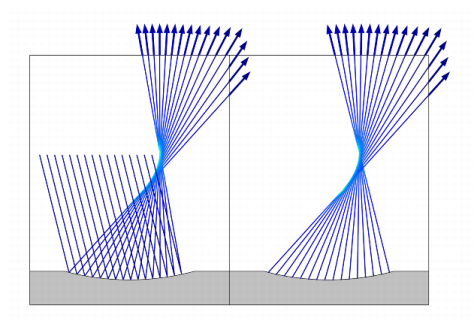For example, when a ray interacts with a Material Discontinuity without undergoing total internal reflection, two rays propagate away from the boundary, including one reflected ray and one refracted ray. The degrees of freedom from the incident ray are re-used as the refracted ray. The additional (reflected) ray that is created during interaction with the
Material Discontinuity is a secondary ray because its initial conditions are not specified directly, but instead result from an existing ray interacting with a boundary. The reflected ray may only be released if the total number of released secondary rays in the model is less than the value of the
Maximum number of secondary rays in the settings window for the physics interface.
Use the Release from Grid feature to specify the initial positions of rays using a grid of points. It is useful to release rays from a grid when the initial ray position is known exactly. A grid-based release may be used, for example, when rays are released from the focus of a lens or when a system is excited by a laser. This is the easiest way to release rays from points in the void region outside the geometry.
Use the Release feature to release rays from within a set of domains. The initial ray positions are based on the mesh elements within the domain. It is possible to assign a nonuniform initial distribution of rays by entering a function of the spatial coordinates in the
Density proportional to text field.
The Inlet feature is used to release rays from boundaries. It is possible to release rays based on the boundary mesh, by specifying a function for the initial density of rays, or by projecting a grid of points onto the surface. The
Inlet feature may be used when rays enter a system through an aperture of considerable size. It is also possible to initialize the principal radii of curvature of the rays using the curvature of the inlet surface.
The Release from Data File node can be used to import the initial ray positions and directions from a text file. It is also possible to import the initial values of user-defined auxiliary dependent variables.
As shown in Figure 2-4, the
Illuminated Surface feature can be used to compute the ray trajectories that result from launching a plane wave at a specularly reflecting surface. The Stokes parameters and the principal radii of curvature of the wavefront are also initialized based on the type of incident wave and the curvature of the surface. Therefore it is unnecessary to compute the trajectories of rays before they hit the surface, which may save a significant amount of time and make plots much easier to interpret.
The Solar Radiation feature is similar to the
Release from Grid feature but includes dedicated settings for computing the direction of incident radiation using the time and location on Earth’s surface. Because rays are given initial radii of curvature of the same order of magnitude as the distance from the earth to the sun, they behave as plane waves in most applications.

